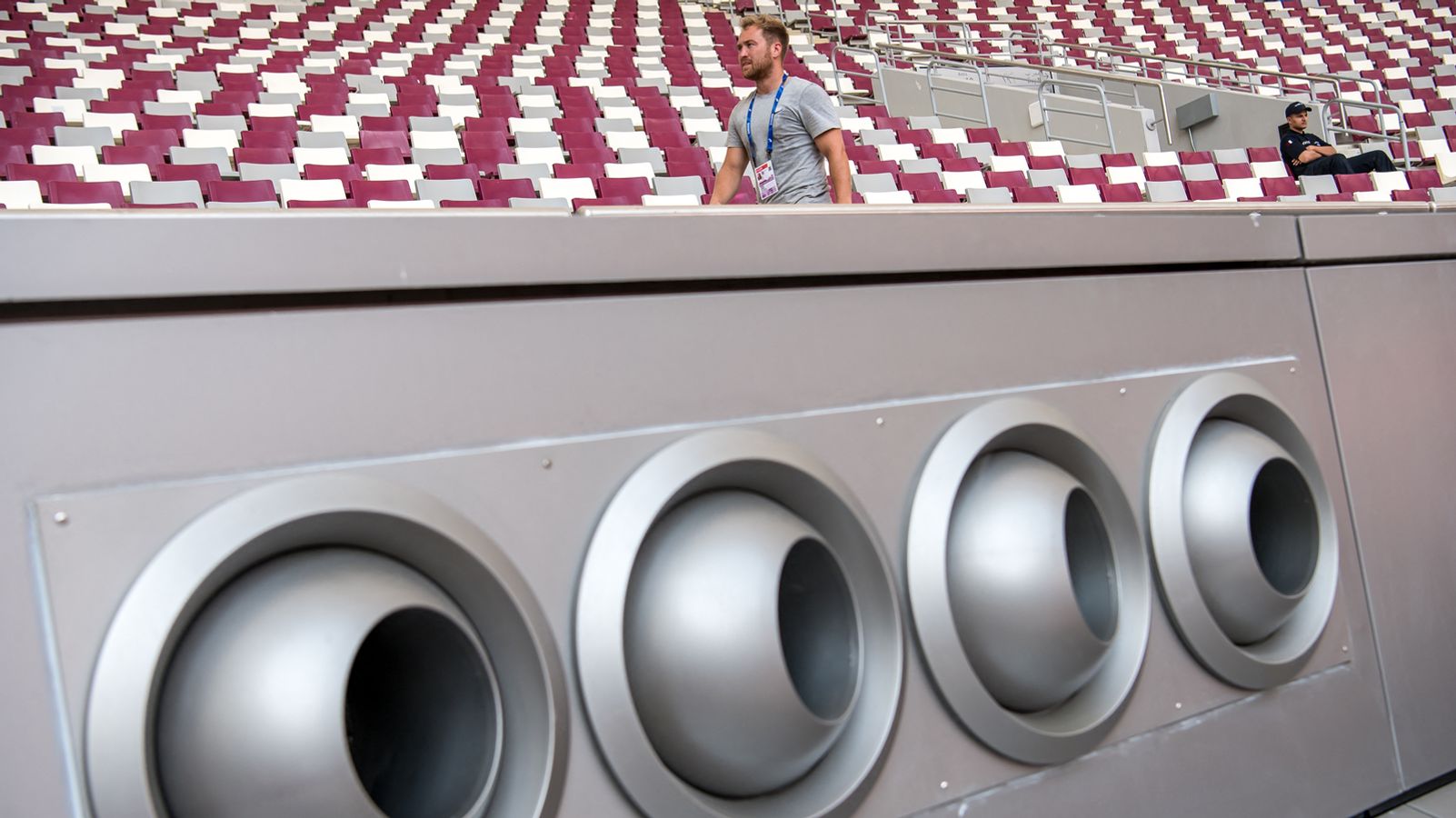Claim: Huge cooling jets to cool stadiums in Qatar
A post on Twitter claims that giant jets are to cool down stadiums for the FIFA World Cup, which takes place this year from November 20 to December 18. In the commentary on the picture, by combining the two sentences “These are the air conditioners in the World Cup stadiums in Qatar” and “Please don’t forget to turn off the lights at home and save electricity in general”, the impression is created that while we have to save energy in Germany, it is being wasted in Qatar for cooling stadiums during the World Cup.
Photos actually show a World Cup stadium in Qatar
The research of #Faktenfuchs based on photo backward searches proves: The photos show the Khalifa International Stadium in the Qatari capital Doha. It is one of a total of eight stadiums that will host competitions during FIFA’s World Cup in late 2022. The pictures were taken by freelance photographer Karim Jaafar, who says he took them at the Khalifa International Stadium on May 18, 2017, and uploaded them to the Getty Images platform the same day.
The photos show large gray nozzles from different perspectives, placed directly along the stands below the seats. These nozzles are part of a cooling system that is designed to cool the field and the stands during events. This is from temperatures of up to 48°C in the summer and 40°C in the winter to a range of between 19°C and 23°C. These cooling systems are installed in seven of the eight World Cup stadiums, including the Khalifa International Stadium in Doha, according to an article (as of Oct. 18, 2021) on the official Qatar World Cup website. The cooling systems are similar and therefore comparable, but they are adapted in each case to the shape of the stadium or the outside temperature, the text says.
Technology is supposedly energy-saving – here’s how it works
Saud Abdul Ghanie is a professor at the College of Engineering at Qatar University and, as a senior engineer, has been responsible for developing and overseeing these cooling technologies at World Cup stadiums since 2009. Abdul Ghanie explains in an interview with the U.S. television station CNN (article as of Nov. 21, 2019) and in an image video (dated Oct. 18, 2021) on the official site of the World Cup in Qatar how the cooling system in the Qatari stadiums actually works.
In the stadium, the hot outside air is cooled by a fan. The cooled air is then blown through the large nozzles shown in the photos onto the pitch and some seats in the stadium.
However, he says, the nozzles only air-condition a two-meter layer of air above the ground, i.e., the playing field and spectator tiers. Abdul Ghanie explains how the other spectator seats in the stadium are supplied with cooled air: Cool air escapes from air grids under the seats. This air is then sucked back in, cooled and filtered again, and blown back into the stadium. This process is repeated over and over again. It is not the entire stadium that is cooled, but only the playing field and the seats.
In addition, the system only needs to be in operation a few hours before and only until the end of the game, Abdul Ghanie said. In principle, he said, the technology is not new; it is already used for cooling outdoor shopping malls or in agriculture, such as greenhouses. The cooling technology will continue to be used after the World Cup, according to information from a presentation on the official World Cup site.
One possible technical detail is not mentioned by the developers
Robert Schießl from the Karlsruhe Institute of Technology (KIT) assumes in response to a #Faktenfuchs inquiry that the technology not only cools the air, but also dehumidifies it, i.e. dries it. An aspect that is not mentioned in the image video or on an official World Cup page where this technology is explained. “You will probably even have to dehumidify to prevent fog formation from cooling,” Schießl writes. This will worsen the energy balance, he adds, because it usually takes more energy to additionally dehumidify the air. Since the people in the stadium are constantly releasing heat and moisture, and the humidity in Qatar in November and December is usually around 60 to 70 percent anyway, there is no way around dehumidification, says Schießl.
However, he, too, has not found more precise figures on this technology to make an accurate analysis. According to Schießl, this principle of air cooling can work in World Cup stadiums because cooler air has a higher density than warm air and therefore usually stays down. Accordingly, the two-meter-high layer above the ground would always be circulated. The warm outside air would then lie as if on a cool cushion of air. However, if there were strong air turbulence, for example if there was wind in the open stadium, then the cold and warm air could mix. This would increase the cooling requirement.
Energy industry in Germany is not comparable with that in Qatar
The #Faktenfuchs asked Günter Meyer, director of the Center for Research on the Arab World (ZEFAW) at Johannes Gutenberg University in Mainz, for an assessment with regard to the conjecture mentioned at the beginning: to what extent is energy wasted in Qatar, while Germany is making efforts to save it? According to Meyer, the situation with regard to energy supply in Germany and Qatar is completely different and should therefore be assessed differently: “Due to the energy crisis, we in Germany as an energy importer have a massive shortage of energy and therefore have to save it.” Qatar, on the other hand, has a huge energy surplus due to its own oil and large natural gas deposits. In addition, with an average sunshine duration of 9.4 hours per day, Qatar has an enormous, as yet largely untapped potential for solar energy, the use of which is being vigorously expanded, especially due to the upcoming World Cup.
Meyer doesn’t share the accusation that arises in the Twitter post: “Why shouldn’t such a country with extremely high daytime temperatures use its surplus of cheap energy to cool the stadiums, to make the stay there as tolerable in terms of temperature as the players and spectators are used to in temperate latitudes?” Meyer writes: Without these commitments, Qatar would not have been chosen to host the World Cup.
For Dawud Ansari of the Stiftung Wissenschaft und Politik (German Institute for International and Security Affairs), the Twitter user’s argument also falls short. For example, he said, when it comes to gas as an energy resource, it is not clear to him what Germany’s energy crisis has to do with Qatar. “There is no global gas crisis, but only a German or European one, which essentially stems from the fact that Germany has vehemently refused to build liquefied natural gas terminals over the last few years, so that currently all import possibilities in Europe are simply exhausted,” Ansari writes in response to a #Faktenfuchs query.
There is enough gas available worldwide. The only problem is that it does not reach Germany. “For the time being, cooling technologies on the Arabian Peninsula are as essential as heating systems in Germany,” says Ansari. According to Ansari, cooling the Qatari stadiums is the least of the problems in the fight against climate change: “Compared to the emissions generated during the construction of the World Cup stadiums and the consumption that occurs in order to jet tens of thousands of fans and players to Qatar and accommodate them in hotels, cooling the stadiums is really an insignificant point.” Accordingly, he said, the event as a whole must be questioned. “To focus only on cooling is really absurd,” Ansari stresses.
Qatar’s World Cup stadiums cooled exclusively with solar energy?
According to Abdul Ghanie, the engineer in charge of the cooling systems in Qatar’s World Cup stadiums, the cooling technology in the World Cup stadiums will be powered exclusively by energy from a solar park near Doha. However, on the official World Cup site and also in the official documents linked there, no further details are given about the solar park, its output or the energy consumption in the World Cup stadiums.
Günter Meyer of the Center for Research on the Arab World suspects that it could be the solar park in Al Kharsaah in Qatar. His assessment coincides with information published by the French oil company TotalEnergies on its website at the beginning of 2022: According to this information, the company – together with a consortium – is involved in the development of the solar park in Al Kharsaah.
The plan is to build “the world’s largest solar power plant”, which will have a size of ten square kilometers after completion, corresponding to an area of 1,400 soccer fields. It is expected to be fully operational in the second half of 2022. This timetable leaves open whether the cooling systems in the World Cup stadiums will already be supplied with energy by the solar park now or exclusively at the time of the World Cup. Also, because TotalEnergies is still talking about the solar park in Al Kharsaah being connected to the Qatari power grid later this year in an article dated July 8, 2022.
Qatar invests “massively” in solar power ahead of World Cup
According to company information from co-developer TotalEnergies, the solar farm is expected to save a total of about 26 million tons of CO2 and meet ten percent of Qatar’s peak electricity demand, the highest electricity demand measured in the country during a given period. “It is conceivable that this could actually cover the energy demand for cooling the stadiums,” writes Günter Meyer of the Center for Research on the Arab World in response to a query from #Faktenfuchs, adding, “However, apart from the sweeping claims made by the organizers, I am not aware of any detailed data that can clearly prove that solar power is actually capable of providing the energy demand for cooling the stadiums.”
For Meyer, however, there has been a clear move by Qatar toward renewables in recent years, “The installation of solar started 15 years ago in Qatar. However, it reached only a very small scale before 2020 and was largely negligible. Since 2020, however, we’ve seen a massive expansion of solar.” These are mostly small local projects in Qatar, he said. The solar park in Al Kharsaah is the only large-scale project so far, he said. According to Meyer, the expansion of solar energy is to continue and solar energy is to cover a 20 percent share of Qatar’s energy supply by 2030.
Conclusion
Photos spreading on Twitter show a refrigeration unit at the Khalifa International Stadium – and indeed one of the stadiums in Qatar that will host the FIFA World Cup competitions. But the impression created by a user comment is misleading. Energy is not necessarily wasted by cooling the stadiums. According to experts, the energy industry in Germany and the associated current energy crisis cannot be compared with that of Qatar.
Follow us and check out our social media accounts on Twitter, Facebook & YouTube ►
● on Twitter ► esport.directory
● Facebook ► esport.directory
● Youtube ► esport.directory
FIFAtips, FIFAtricks, FIFAcheats, FIFAhacks, FIFAhacks2022, FIFA2tipspro, FIFApaidcheats, FIFA, FIFAtipsandtricks, FIFAtipsandtricks2022, FIFA2tipsandtricksforbeginners, FIFA2tips, FIFAtricks, FIFAtrickshots, FIFAhacks, FIFAhacksfree, FIFAhacksfree2022,




